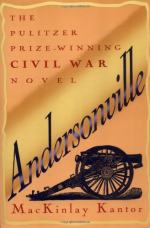The clothing upon the upper part of my body had been reduced to the remains of a knit undershirt. It had fallen into so many holes that it looked like the coarse “riddles” through which ashes and gravel are sifted. Wherever these holes were the sun had burned my back, breast and shoulders deeply black. The parts covered by the threads and fragments forming the boundaries of the holes, were still white. When I pulled my alleged shirt off, to wash or to free it from some of its teeming population, my skin showed a fine lace pattern in black and white, that was very interesting to my comrades, and the subject of countless jokes by them.
They used to descant loudly on the chaste elegance of the design, the richness of the tracing, etc., and beg me to furnish them with a copy of it when I got home, for their sisters to work window curtains or tidies by. They were sure that so striking a novelty in patterns would be very acceptable. I would reply to their witticisms in the language of Portia’s Prince of Morocco:
Mislike
me not for my complexion—
The
shadowed livery of the burning sun.
One of the stories told me in my childhood by an old negro nurse, was of a poverty stricken little girl “who slept on the floor and was covered with the door,” and she once asked—
“Mamma how do poor folks get along who haven’t any door?”
In the same spirit I used to wonder how poor fellows got along who hadn’t any shirt.
One common way of keeping up one’s clothing was by stealing mealsacks. The meal furnished as rations was brought in in white cotton sacks. Sergeants of detachments were required to return these when the rations were issued the next day. I have before alluded to the general incapacity of the Rebels to deal accurately with even simple numbers. It was never very difficult for a shrewd Sergeant to make nine sacks count as ten. After awhile the Rebels began to see through this sleight of hand manipulation, and to check it. Then the Sergeants resorted to the device of tearing the sacks in two, and turning each half in as a whole one. The cotton cloth gained in this way was used for patching, or, if a boy could succeed in beating the Rebels out of enough of it, he would fabricate himself a shirt or a pair of pantaloons. We obtained all our thread in the same way. A half of a sack, carefully raveled out, would furnish a couple of handfuls of thread. Had it not been for this resource all our sewing and mending would have come to a standstill.




